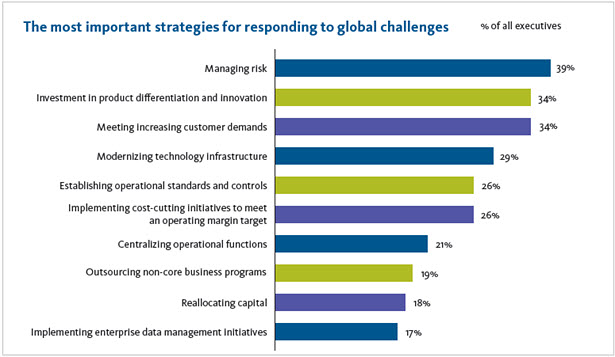Operations Power Performance: Managing Risk and Delivering Value
Survey of financial services executives identifies challenges and highlights operations as a driver of growth.
Business power of operational change For the first time in the modern financial-services era, the majority of business leaders appreciate the transformative power of operations and are eager to have the chief operating officer (COO) play a leading role in driving business model change. In today’s connected, global business environment, COOs have greater visibility on regulation, changes in market structure and shifting client needs.
Today’s more complex business context—shaped by globalization, increased regulation, market shifts and technological advances—pushes companies to look beyond core operations to be more dynamic in terms of meeting customer demands, expanding into new markets and providing a safe and reliable investorcentric environment. Indeed, our survey reveals that expanding into new markets is the overarching business orientation for most organizations and that more intense regulation and changes in market/industry structure are the most daunting challenges they face.
Top findings from the survey:
- Increasingly intense regulation and governance, and changes in market structure, are cited as the key forces driving business transformation today.
- Forty-three percent of executives name building automated processes that integrate risk management, audit trails and compliance processes as the most effective strategy for adapting to more intense regulatory and governance requirements.
- Risk management is rated by most executives as the most important overall strategy in their organization’s response to global challenges.
- There is an expectation, especially among C-suite executives, that operational leaders will initiate proposals to advance the organization’s broad strategic goals. About 84% of the C-level respondents from high-performing firms agree that this is already the case in their firm, compared with only 69% of less-adaptable companies.
- Firms with strong adaptability performance are more likely to say they will invest in a wide range of key operational activities, including risk management, compliance, front office and customer onboarding.
The new normal: Regulatory change
The highly regulated, increasingly global and constantlychanging landscape has become the “new normal” for financial firms. Securities-related companies—both on the buy and sell side—are re-evaluating their business models as they refine their strategies to tackle ongoing challenges, including intensified regulation and governance, growing globalization and changes in industry and market structure.
Increasingly intense regulations and governance and changes in market structure stand out as the key forces currently driving business transformation. These two factors are cited by 35% and 32% of executives, respectively, as the top challenges to the success of their organizations. Executives also say that managing risk (39%) is the most important overall strategy for responding to these challenges, followed by investment in product differentiation and innovation and meeting increasing customer demands, both with 34% (see chart below).

About the Survey
The Economist Intelligence Unit, in partnership with Broadridge, conducted a survey to ascertain how operational teams are contributing business value to their companies, garnering responses from 414 executives from around the world engaged in securities-related businesses. Leaders of buy-side operations, sell-side operations and corporate management are nearly equally represented. More than 40% of survey respondents hold C-level positions, including 19% who are CEOs. Asia-Pacific, North America and Europe each account for about 30% of the survey sample. About one-quarter of the companies represented have $5bn or more in annual global revenue, while 39% have less than US$1bn in revenue.